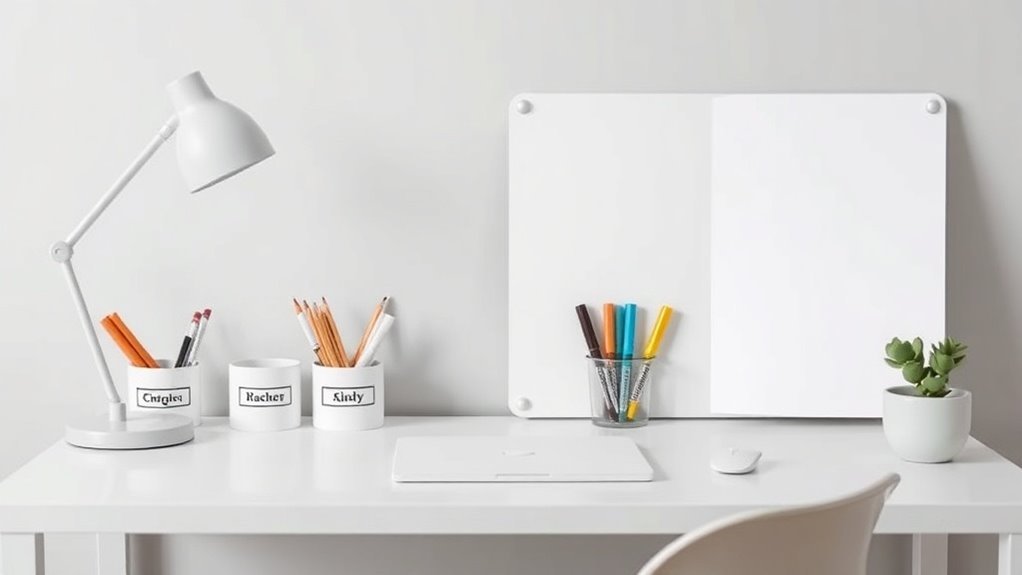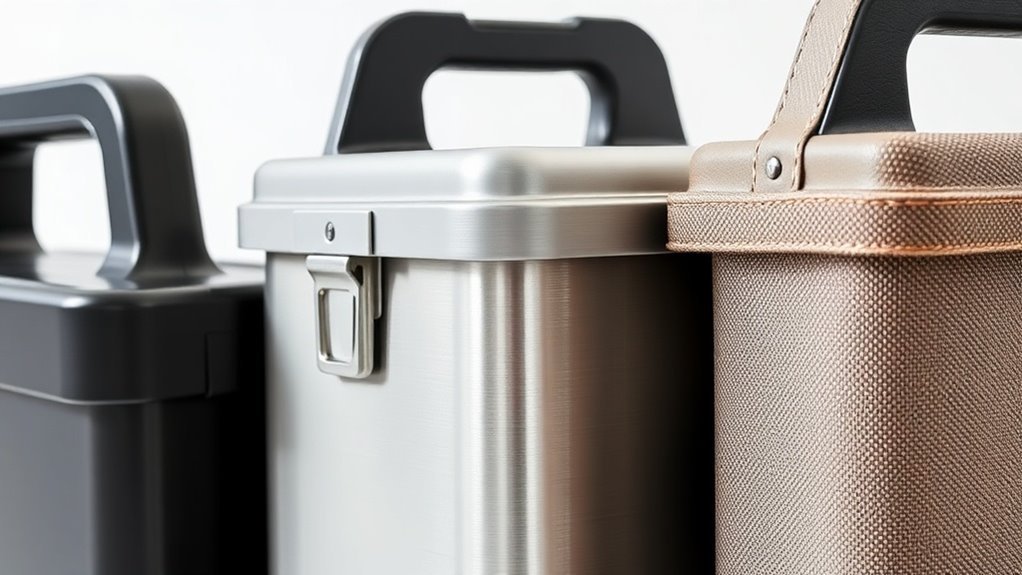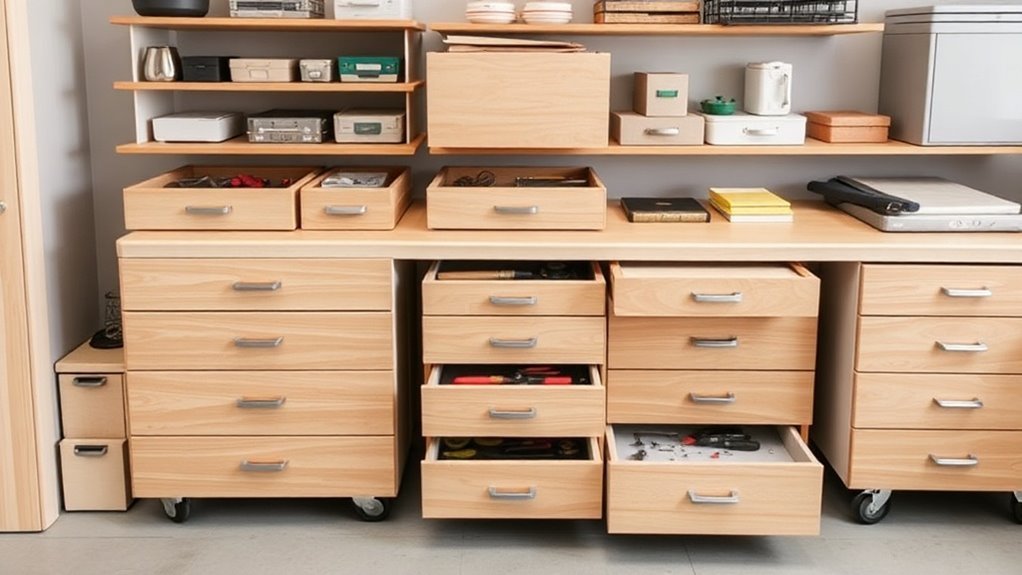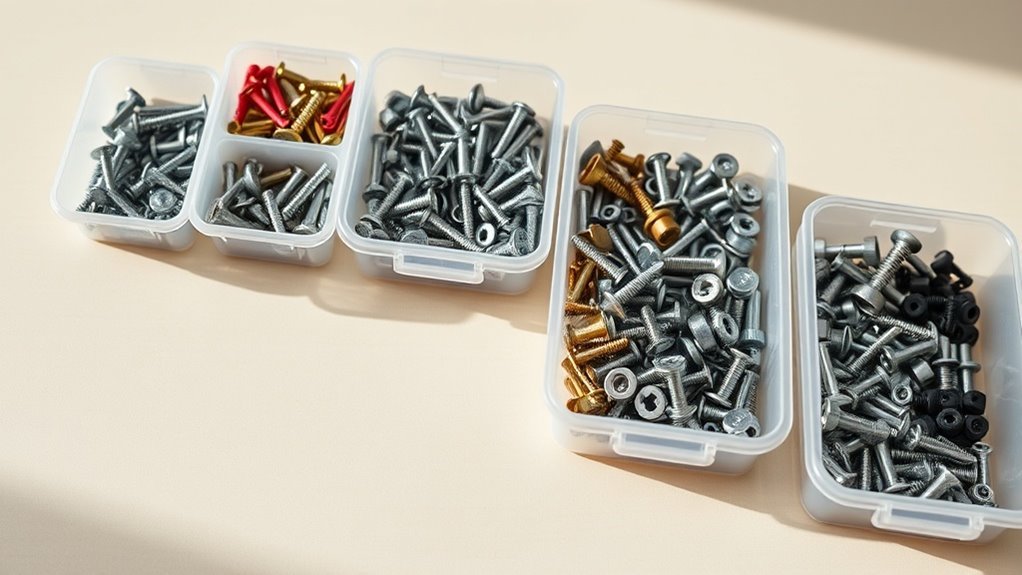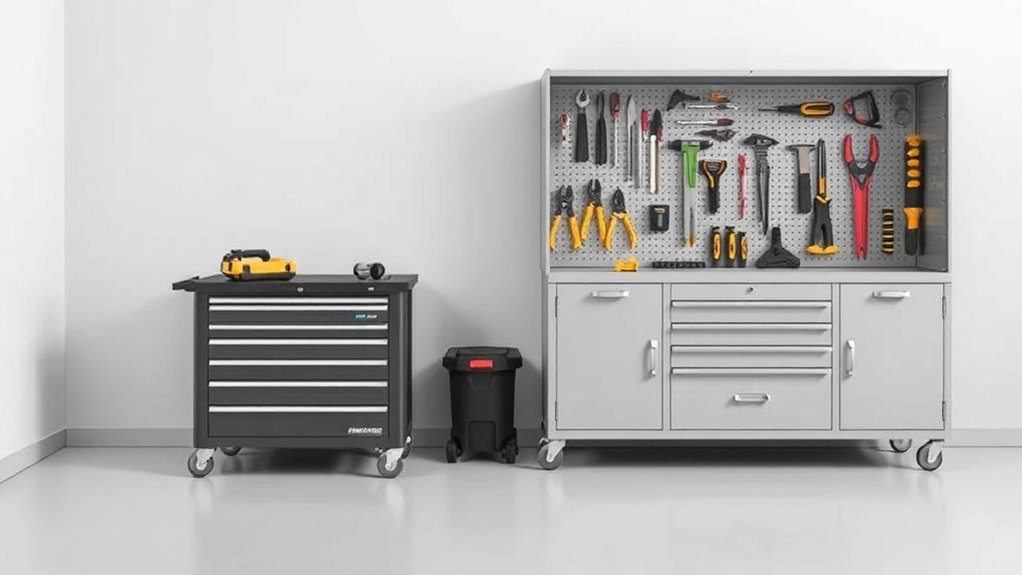Safety Considerations in Tool Storage Design
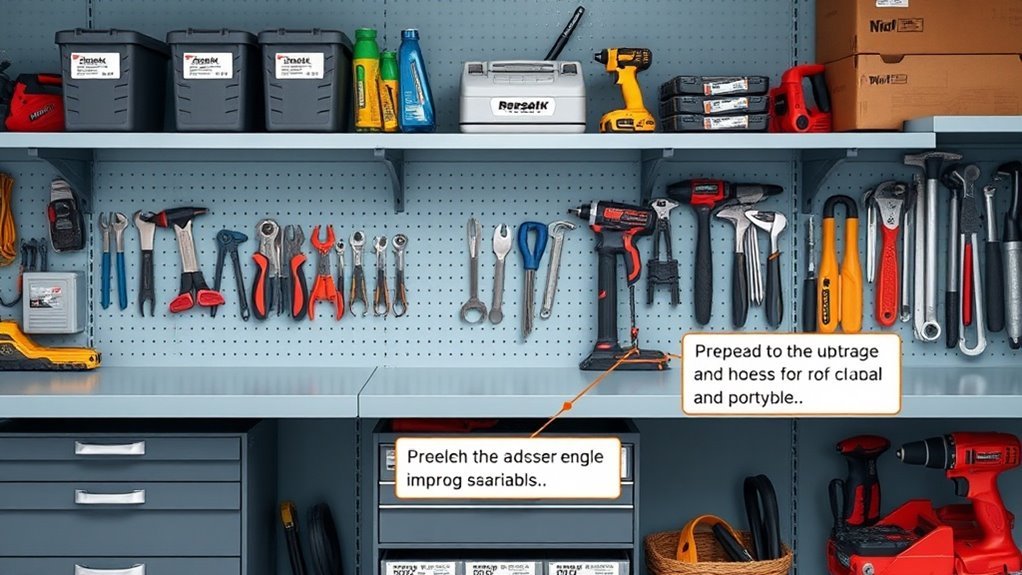
When designing tool storage, prioritize safety by choosing durable, moisture-resistant materials. Organize tools for easy access and label them clearly to prevent accidents. Implement secure storage solutions, like lockable cabinets, and use foam inserts to minimize movement during transport. Regularly inspect and maintain your storage systems to guarantee they’re safe and functional. Keeping your workspace tidy also helps reduce hazards. If you want to learn more about optimizing your tool storage for safety, there’s much more to explore.
Key Takeaways
- Use durable, moisture-resistant materials to minimize rust and ensure long-lasting, safe storage systems.
- Implement secure storage solutions, like lockable cabinets, to prevent unauthorized access and potential theft.
- Organize tools with clear labeling and categorized storage to enhance accessibility and reduce the risk of accidents.
- Regularly inspect and maintain storage systems to ensure they remain functional, safe, and free from wear and tear.
- Incorporate proper mounting for large tools and secure loose items to prevent falls and injuries in the workspace.
Choosing the Right Storage Materials
When it comes to choosing the right storage materials for your tools, understanding the specific needs of your workspace is vital.
You’ll want to prioritize durability, especially if your tools are heavy or frequently used. Steel and heavy-duty plastic are excellent choices, as they can withstand wear and tear while providing protection.
Consider moisture-resistant materials if your workspace is humid, preventing rust and corrosion.
In humid workspaces, opt for moisture-resistant materials to safeguard against rust and corrosion.
Don’t overlook organization; shelves, racks, and bins help keep your tools in order, so you can find them quickly.
Think about mobility too; if you need to move materials around, lightweight options or storage on wheels can be beneficial.
Ultimately, selecting the right materials guarantees your tools stay safe and accessible. Additionally, using proper storage containers helps protect both the tools and the user from accidents.
Organizing Tools for Accessibility and Safety
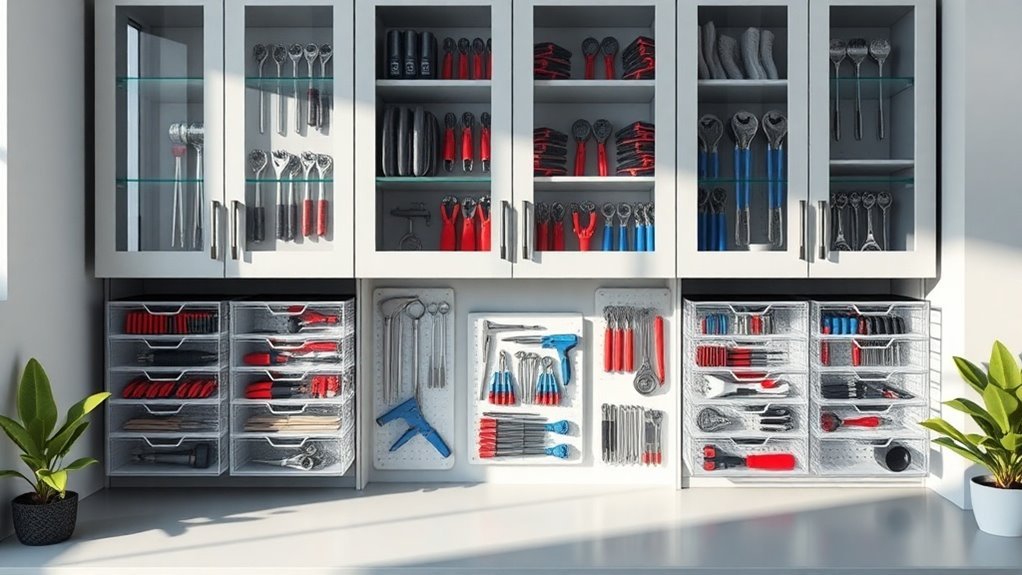
When organizing your tools, you’ll want to focus on accessibility and safety.
Implementing a clear labeling system, adjustable storage solutions, and secure placements can make a big difference in how efficiently you work. Additionally, utilizing modular storage systems allows for tailored organization that adapts to your workspace’s needs.
Let’s explore how these strategies can streamline your space and keep you safe.
Clear Labeling Systems
A clear labeling system is vital for effective tool organization, enhancing both accessibility and safety in any workspace. It helps you quickly locate the tools you need without rummaging through clutter.
By using simple colors, icons, or names, you make it intuitive for anyone to understand where each tool belongs. This is especially critical in a busy environment, where time is of the essence, and mistakes can be hazardous.
Additionally, proper labeling minimizes the risk of using the wrong tool, reducing accidents. Guarantee labels are durable and placed visibly on storage units, cabinets, and drawers.
When tools are easily identified and returned to their designated spots, you’ll foster a safer, more productive workspace for everyone involved.
Adjustable Storage Solutions
Organizing tools effectively goes beyond clear labeling; it often involves adopting adjustable storage solutions that enhance accessibility and safety.
Flexible shelving, pegboards, and modular bins allow you to customize your storage to fit both the tools and the space available. By adjusting shelves or compartments, you can keep frequently used tools at eye level, reducing the risk of accidents when reaching for them.
It’s also easier to spot items at a glance, which helps minimize unnecessary movement around the workspace. Additionally, adjustable solutions can adapt as your collection grows or changes, ensuring you always have a safe, organized environment.
Investing in these solutions can make all the difference in maintaining a functional workspace.
Secure Tool Placement
Effective tool placement can considerably enhance both accessibility and safety in your workspace. To start, you should categorize your tools based on their frequency of use. Place everyday items within easy reach and store less frequently used tools higher up or farther away to minimize clutter.
Consider using wall-mounted racks or magnetic strips for tools you need at a moment’s notice, keeping them visible and accessible. Additionally, guarantee heavy items are stored at waist level to avoid lifting injuries. Always secure loose tools while in storage; toolboxes with locking systems can help prevent accidents.
Regularly check your organization system and adjust as needed, ensuring that every tool has a designated spot. This proactive approach can foster a safer, more efficient working environment.
Implementing Secure Storage Solutions
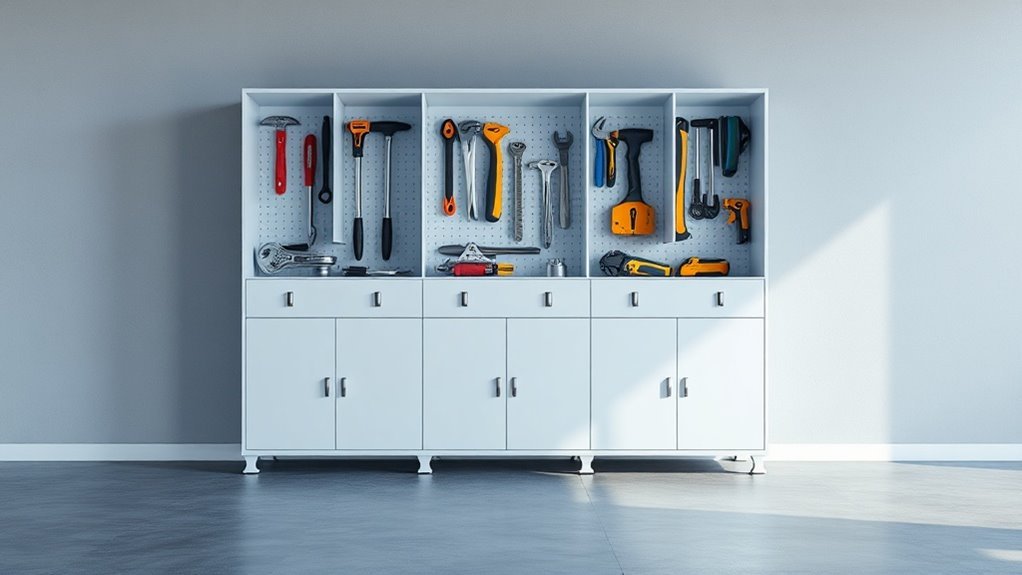
When you’re working with tools, guaranteeing they’re stored securely is essential for both safety and efficiency.
Start by investing in a sturdy storage solution, like a toolbox or cabinet, designed to lock. Make use of proper mounting systems for larger tools; wall-mounted brackets can keep them off the floor and deter accidents.
Invest in a secure toolbox or cabinet and use wall-mounted brackets to keep larger tools safe and accessible.
Consider using foam inserts or padded organizers to keep tools from moving around during transport. Label each section to make it easy to find what you need quickly.
For added security, think about implementing surveillance or access controls, especially in shared or commercial spaces. This way, you reduce the risk of theft and guarantee only authorized personnel can access your tools.
Proper storage not only protects your tools but also enhances workplace safety. Additionally, selecting the right type of tool storage solution—whether mobile for flexibility or fixed for stability—can also play a key role in minimizing hazards and optimizing organization.
Maintaining a Clean and Tidy Workspace
Keeping a clean and tidy workspace is essential not only for safety but also for productivity. When tools are organized and stored properly, you can easily find what you need, reducing the risk of accidents caused by clutter.
Make it a habit to put away tools immediately after use, ensuring they’re in designated storage areas. Regularly inspect your workspace for any hazards, like spills or misplaced items, and address them promptly. Dispose of trash and unnecessary materials to maintain an inviting atmosphere.
A clear workspace helps you stay focused and efficient, enabling you to complete tasks without distractions. Ultimately, nurturing this cleanliness habit fosters a safer environment and enhances your overall workflow. Implementing systematic arrangement can greatly improve the organization of your tools.
Prioritize it, and your productivity will likely improve.
Educating Staff and Family on Tool Safety
How can you guarantee everyone around you understands the importance of tool safety? Start by holding regular training sessions. These can be brief yet effective discussions about safe tool usage, proper storage, and potential hazards.
Use real-life examples to demonstrate the consequences of negligence. Encourage open dialogue where staff and family members can share their concerns or experiences.
Demonstrating real-life consequences encourages open dialogue about tool safety, fostering a proactive safety culture.
Incorporate visuals, like charts or videos, to make the information more digestible. Make tool safety part of your daily routine; remind everyone to adhere to established guidelines.
Providing easy access to safety instructions and checklists can reinforce good practices. Additionally, emphasize the value of using personal protective equipment to safeguard against accidents. By fostering a culture of safety, you’ll ascertain that everyone is knowledgeable and motivated to maintain a safe environment.
Regularly Inspecting and Updating Storage Systems
Regular inspections and updates of your tool storage systems are essential for maintaining safety and organization. Take time to check for any wear and tear on shelves, bins, and containers. If you notice any damage, replace or repair them immediately to prevent accidents.
Make sure that tools are stored properly, ensuring they’re easily accessible and secured to avoid falls or clutter.
Additionally, review your inventory regularly. As tools are added or removed, your storage needs may change. Adjusting your system to reflect these changes keeps everything in order and minimizes hazards. Implementing a method for categorizing tools by frequency helps streamline your organization even further.
Engaging in routine inspections not only enhances safety but also extends the life of your storage systems. Stay proactive to create a safer working environment for everyone involved.
Questions
What Type of Tools Require Specialized Storage Considerations?
Hand tools, power tools, and sharp instruments need specialized storage. You should make certain proper organization, climate control, and protection from moisture or dust. Also, remember to secure hazardous tools away from children’s reach.
How Can I Prevent Rust and Corrosion in Tool Storage?
Did you know about 30% of tools succumb to rust? To prevent this, store your tools in a dry, climate-controlled area, use rust inhibitors, and regularly clean them to eliminate moisture and contaminants.
Are There Eco-Friendly Storage Options Available for Tools?
Yes, there are eco-friendly storage options for tools. Consider using bamboo or recycled materials for your storage solutions. They’re sustainable, durable, and help minimize environmental impact while keeping your tools organized and accessible.
What Impact Does Temperature Have on Tool Storage Materials?
Extreme temperatures can warp plastic and crack wood, yet moderate conditions preserve durability. You’ll want to store tools in a climate-controlled space, ensuring materials remain intact, enhancing functionality and prolonging their lifespan. It’s worth considering.
How Can I Customize Storage for Unusual-Shaped Tools?
You can customize storage for unusual-shaped tools by using foam inserts or adjustable shelving. Consider creating compartments tailored to their dimensions, or utilizing pegboards with hooks for easy access and organization. Personalize it for your specific tools!
Conclusion
To create a safe storage sanctuary for your tools, remember to prioritize practical organization and protective measures. By smartly selecting sturdy materials and maintaining a meticulous workspace, you’ll minimize mishaps and maximize efficiency. Don’t forget to educate everyone involved about safety and regularly reassess your storage systems. With a little diligence and dedication, you’re bound to build a brilliant and balanced tool storage solution that keeps both tools and users safe and sound.

